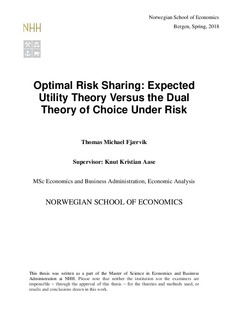Optimal risk sharing : expected utility theory versus the dual theory of choice under risk
Master thesis
Permanent lenke
http://hdl.handle.net/11250/2560029Utgivelsesdato
2018Metadata
Vis full innførselSamlinger
- Master Thesis [4372]
Sammendrag
An introduction to the dual theory of choice under risk is given. Optimal risk sharing under
both expected utility theory and the dual theory of choice under risk is reviewed. Central
results to insurance in pure demand theory is found to be very similar under both theories.
The exception is optimal coinsurance. Central results are also found to be similar
concerning Pareto optimal risk sharing between an insurer and a potential policyholder, but
some differences arise. The general structure of Pareto optimal risk sharing is affected by
the underlying choice theory. For both Pareto optimal risk sharing and pure demand theory
similarities/differences are attempted explained by properties underlying the respective
choice theories. A brief introduction to distortion risk measures and their relation to the
dual theory of choice under risk is given. Before the concluding remarks, a brief discussion
concerning the normative and descriptive validity of each choice theory is presented. In
general it seems that the dual theory of choice models risk sharing between firms well, while
expected utility theory models risk sharing concerning individuals well. This seems to be a
result of agents’ attitudes towards wealth under the different theories.
